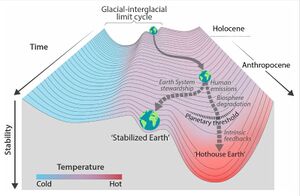Climate state: Difference between revisions
mNo edit summary |
m (Add study results) |
||
| (One intermediate revision by the same user not shown) | |||
| Line 1: | Line 1: | ||
The climate state describes the climatic situation on a planet. Researchers isolated four different climate states, Hothouse, Warmhouse, Coolhouse, and Icehouse.<ref>Zachos et al. 2020 [https://www.science.org/doi/10.1126/science.aba6853 An astronomically dated record of Earth’s climate and its predictability over the last 66 million years] | [[File:Trajectories-of-the-Earth-System-Anthropocene-Pathway-of-Earth-System-Holocene.jpg|thumb|right|Stability landscape showing the pathway of the Earth System out of the Holocene and thus, out of the glacial–interglacial limit cycle to its present position in the hotter Anthropocene. The fork in the road in Fig. 1 is shown here as the two divergent pathways of the Earth System in the future (broken arrows). Currently, the Earth System is on a Hothouse Earth pathway driven by human emissions of greenhouse gases and biosphere degradation.]] | ||
These major climate states persisted for millions and sometimes tens of millions of years, and within each one the climate shows rhythmic variations corresponding to changes in Earth’s orbit around the sun. But each climate state has a distinctive response to orbital variations, which drive relatively small changes in global temperatures compared with the dramatic shifts between different climate states. | The '''climate state''' describes the climatic situation on a planet. Researchers isolated four different climate states, Hothouse, Warmhouse, Coolhouse, and Icehouse.<ref>Zachos et al. (2020) [https://www.science.org/doi/10.1126/science.aba6853 An astronomically dated record of Earth’s climate and its predictability over the last 66 million years] Science</ref> | ||
<ref>Tim Stephens 2020 [https://news.ucsc.edu/2020/09/climate-variability.html High-fidelity record of Earth’s climate history puts current changes in context] | These major climate states persisted for millions and sometimes tens of millions of years, and within each one the climate shows rhythmic variations corresponding to changes in Earth’s orbit around the sun. But each climate state has a distinctive response to orbital variations, which drive relatively small changes in global temperatures compared with the dramatic shifts between different climate states.<ref>Tim Stephens (2020) [https://news.ucsc.edu/2020/09/climate-variability.html High-fidelity record of Earth’s climate history puts current changes in context] UC Santa Cruz</ref> | ||
==General== | |||
The 2018 study ''Trajectories of the Earth System in the Anthropocene'' proposed a planetary threshold at ∼2 °C above the preindustrial level, at which self-reinforcing feedbacks would steer Earth into the hothouse climate state, with global average temperature not seen in the past 1.2 million years and [[sea level rise]] of 10 meters or more.<ref>Will Steffen, Johan Rockström, Katherine Richardson, Hans Joachim Schellnhuber (2018) [https://www.pnas.org/doi/10.1073/pnas.1810141115 Trajectories of the Earth System in the Anthropocene] PNAS</ref> | |||
==References== | ==References== | ||
Latest revision as of 09:36, 12 May 2023

The climate state describes the climatic situation on a planet. Researchers isolated four different climate states, Hothouse, Warmhouse, Coolhouse, and Icehouse.[1] These major climate states persisted for millions and sometimes tens of millions of years, and within each one the climate shows rhythmic variations corresponding to changes in Earth’s orbit around the sun. But each climate state has a distinctive response to orbital variations, which drive relatively small changes in global temperatures compared with the dramatic shifts between different climate states.[2]
General
The 2018 study Trajectories of the Earth System in the Anthropocene proposed a planetary threshold at ∼2 °C above the preindustrial level, at which self-reinforcing feedbacks would steer Earth into the hothouse climate state, with global average temperature not seen in the past 1.2 million years and sea level rise of 10 meters or more.[3]
References
- ↑ Zachos et al. (2020) An astronomically dated record of Earth’s climate and its predictability over the last 66 million years Science
- ↑ Tim Stephens (2020) High-fidelity record of Earth’s climate history puts current changes in context UC Santa Cruz
- ↑ Will Steffen, Johan Rockström, Katherine Richardson, Hans Joachim Schellnhuber (2018) Trajectories of the Earth System in the Anthropocene PNAS